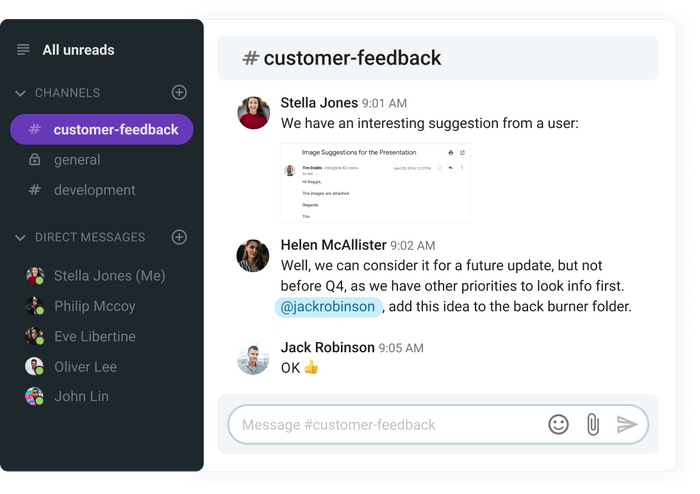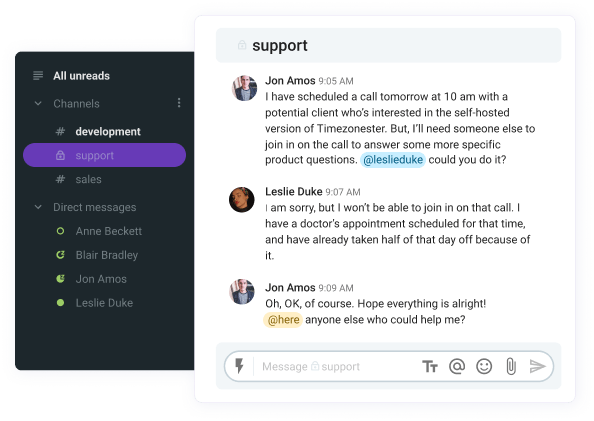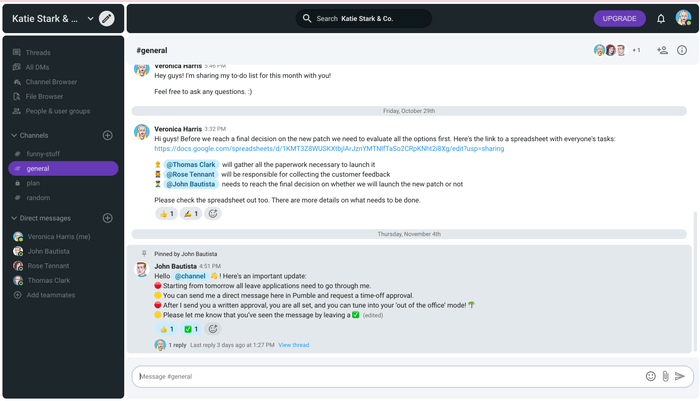Improving your work message skills is paramount to succeeding at work. You don’t necessarily need to have writing or communication tasks in your job description to be required to communicate effectively using some type of writing format at work.
Whether you’re engaging in email correspondence with your clients, or communicating internally using a team messaging app such as Pumble, most of your work communication is carried out in a written form.
However, it can be extremely challenging to get the right message across when engaging in written communication at work. A lack of verbal and non-verbal cues can present serious challenges — especially for remote team members that may have never met in person, and rely solely on digital communication to collaborate and build relationships.
Written work communication, thus, lends itself to misinterpretation and misunderstandings — which can seriously hinder team connectivity and overall organizational success.
In this article, we will cover the importance of strong work message skills, and outline an extensive list of actionable tips on how to improve your writing skills.

Table of Contents
Why are writing skills important for crafting work messages?
Strong writing skills may not only come as a nice bonus in your work resume — they can often be a determining factor in getting the job in the first place. In fact, 70% of business leaders in a 2004 study report that two-thirds of their employees have writing responsibilities as their job descriptions. We can safely assume this percentage is way higher now, given that entire organizations operate remotely and conduct most of their internal communications in writing.
Solid work message skills are especially important in today’s globally-oriented markets with remote and hybrid teams that rely on asynchronous communication to collaborate successfully. When two teams that collaborate on a joint project operate in different time zones, strong writing skills become key catalysts for success. Clear, concise, and coherent work messages help teams allocate tasks, share feedback and progress, solve issues, and overall collaborate more effectively.
According to Eric Toll — communications manager at Phoenix Community and Economic Development — strong business writing promotes credibility and professional development.
“Formal writing is a testament to an individual’s knowledge and experience. Spelling and grammatical errors undermine professional credibility. This is particularly important when advocating for issues, preparing legal documents, or being persuasive. Writing paves the road to career advancements.”
Let’s get a closer look at how writing skills impact work messages and collaboration in general.
Strong work message skills reduce misunderstandings and miscommunication
Successful collaboration depends on effective communication between team members. A lack of clarity or accuracy in work message exchange can lead to miscommunication which can then cause delays, duplicate work, and overall loss of productivity. The specific nature of written communication requires organizations and individuals to place special emphasis on how they craft vital work messages to be able to avoid the common challenges of written business communication.
Strong writing skills help communicate tasks more clearly
Team leaders and managers are well aware of the importance of strong writing skills when assigning and communicating tasks with employees.
A team leader that fails to communicate all the details coherently and clearly is more likely to spend more time in back-and-forth emails or DMs with team members requesting clarifications.
The same goes for any cross-functional or team members collaboration — the ability to get your point across correctly in writing largely determines how team members will understand and collaborate on a task.
Strong writing skills allow employees to form better work relationships
When people are committed to developing their writing skills, there’s less room for misinterpretation and potential conflicts between coworkers. We’ve all witnessed clumsy phrasing or messages that can be misinterpreted as passive-aggressive in our team chat app conversations, for example.
Strong writing, on the other hand, ensures better workplace communication and relationships, with reduced opportunities for misinterpretation or conflicts. Even though written communication doesn’t necessarily provide an insight into the writer’s mood or emotions, a skillful writer knows how to craft a clear, unambiguous message that supports team connectivity.
💡For more on team connectivity in a remote work setting, check out our guide on how to help your remote team feel more connected.
Tips on how to improve your work message skills
Now that we have a better understanding of how our business writing skills shape our professional environment, it’s time to take the next step and adopt the techniques for improvement.
1️⃣ Start from the purpose
When doing any type of writing, the first thing you need to consider is the purpose of the message you’re communicating. Regardless of the type of text, or the format, every piece of writing has a purpose.
Always keep the purpose of your message in mind.
What do you want to convey? To whom? What do you want the reader to gain from your message? What do you want to achieve for yourself, or your business?
Depending on your goal, your business writing can fall into one of the four main categories:
- ℹ️ Informational — Business writing that includes messages or documents that serve to convey important company information such as policies or project progress to employees.
- 👩🏫 Instructional — A type of business writing that aims to provide steps or directions for completing a task.
- 💬 Transactional — Business writing used in daily communication between members of an organization.
- 💰 Persuasive — A type of business writing mostly used in external communication to convince or nurture clients and customers.
Understanding the objective behind particular work messages you write helps you adjust the style, structure, tone, and language of your work message. It serves as a direction that guides all of your writing choices.
2️⃣ Practice applying the 7 Cs of Communication
The 7 Cs of Communication serve as a guideline for effective and engaging communication. These communication principles apply both to written and verbal communication. Each piece of writing can be assessed using the seven principles.
To improve your work message skills, consider using the following principles as a checklist for each work message you compose:
#1 Confidence — To develop a confident style in your writing, consider demonstrating honesty, assertiveness, and an authentic and clear tone in your writing.

#2 Clarity — To improve the clarity of your writing, consider using short, direct sentences. And make sure to remove any potential filler words and unnecessary jargon.

#3 Conciseness — To achieve conciseness in your writing, be sure to increase the use of active voice and action verbs. And, reduce vague phrasing and unnecessary qualifiers.

#4 Courteousness — Show kindness and common courtesy and express gratitude even in the shortest of messages you post in your company team chat.

#5 Concreteness — Consider optimizing your work messages with concrete facts and figures using active voice and direct language.

#6 Correctness — Consider using grammar tools to make sure your work messages are grammatically correct.
#7 Coherence — To achieve coherence in your business writing, try to organize ideas in your work messages in a logical manner. Ensure that you stick to the main topic, with points presented in a methodical order, connected via transition phrases.

3️⃣ Read and practice
People who spend more time reading are bound to develop better writing skills as a result. Studies have shown that reading impacts vocabulary building and spelling, in addition to supporting overall cognitive development.
Consider making reading a part of your daily routine when working on improving your writing skills. You don’t need to focus solely on specific industry-related reads — feel free to mix things up and pick up a great fiction piece every once in a while as it can boost your creativity and improve the style of your writing. After all, one of the key features in business writing — especially in persuasive writing — is the use of metaphors and analogies to support your claims and paint a clear picture for your managers and peers.
Business writing is not that different from any other skill in the sense that it takes practice to make it perfect. Therefore, consider enrolling in specialized workshops and courses to perfect your work message skills.
4️⃣ Become a storyteller
It may sound counterintuitive, however, successful business writing has a lot in common with regular storytelling. If you want your message to be more engaging and rewarding to your reader, consider following a story structure in your work messages. When you consider work writing from this perspective, you can notice that almost every work message can be structured as a story — with a beginning, middle, and an end.
Let’s say you want to write a message to your team to let them know you’ll be away for a couple of hours due to Internet issues you’re experiencing.
Here’s an example of how you can structure your message as a story:
Beginning: Hi guys, hope everyone is having a lovely day.
Just to let you know I’ll be away for a couple of hours — I hope to get back by 2 PM.
Middle: I’m experiencing some issues with my wi-fi at the moment.
I realized none of the tabs were loading properly so I contacted my internet provider. They are on it and expect to have it all fixed in 2-3 hours.
End: I’ll let you know as soon as I get back, and, in the meantime, feel free to reach me on my phone in case you need anything.
5️⃣ Practice assertive communication
Although traditionally more often related to verbal communication, an assertive style of communication can be applied in written business communication — to achieve better negotiating results and create better work relationships based on mutual respect.
In addition to these benefits, assertive business communication brings substantial individual gains such as:
- improved self-confidence,
- higher job satisfaction, and
- better introspection.
To apply the principles of assertive communication in your work writing, be sure to:
- Take your time to compose a message that clearly states all the points you want to convey.
- Maintain a positive tone — but ensure you’re expressing your stance in a direct and honest manner while being respectful towards other participants in the conversation.
- Inserting emojis in your messages can help you achieve the specific tone you want to convey in your messages — but be sure to check your company policy on using emojis in workplace communication first, as some organizations or writing forms may deem them inappropriate.
💡To get a more in-depth analysis of emoji use, you may find this article useful — Should you use emojis in business communication?

6️⃣ Mind the principles of intercultural communication
If you’re in a distributed, remote team, chances are you’ll collaborate with teammates belonging to diverse cultural backgrounds. Successful teamwork and communication depends on understanding and acknowledging different business customs, beliefs, and communication strategies.
To ensure your business writing is in line with the principles of cross-cultural communication, it might be helpful to first do research on specific cultures and norms — if you need additional information. Overall, pay special attention to using the standard language variant and avoid slang or culture-specific phrases. Moreover, consider reducing the use of humor in your business writing — as some jokes or references can be considered and interpreted as offensive in some cultures.
7️⃣ Avoid clichés and corporate jargon
Written business communication lends itself to stereotypical phrasing and the extensive use of clichés, especially in email correspondence. In most cases, the use of corporate jargon and overused industry buzzwords reduces the clarity of your work messages and doesn’t add any tangible value to your writing. A direct approach with simple words and phrases is a more effective alternative that will help you polish up your writing and get the right message across.
Additional tips on how to formulate work messages
In addition to understanding the do’s and don’ts of professional writing in general, another important aspect of business writing is learning how to properly craft your work messages. To help you get a better understanding of all the steps that go into formulating successful work messages, we’ve compiled the list of actionable steps you can use as a checklist any time you need additional guidance.
Create an outline
To better organize your points and ensure your messages are structured to follow a logical direction, try to begin your writing with an outline. This is a common practice for longer documents or pieces of content, however, the same rules apply to shorter message exchanges between teammates in a team chat app.
To create an effective outline, add all the points and pieces of information you want to cover and arrange them by importance or relevance. Then, you can write the entire message around these points without the risk of missing an important piece of information and having to send multiple follow-up messages to clarify.
Mind the context
The second most important point to consider when formulating your work messages is adjusting the style of your writing to the context in which the conversation is taking place.
For example, when exchanging messages with your teammates in the #random channel in your team chat app, you’ll likely use a more informal style with plenty of emojis, GIFs, or memes.

Conversely, the messages you post in the #general channel will take on a more formal tone with special attention to grammar, spelling, and the overall clarity and accuracy of the information shared.

Adjust the style and tone to your audience
The style and tone of your work writing will vary depending on the audience you’re addressing. At the same time, having your readers in mind when crafting a message can inform your writing choices. As much as an overly formal tone would perfectly fit an email correspondence with a company senior partner, for example, your teammates in a private channel in your company team chat app would find this tone strange, and vice versa.
Keep it short
As our attention span is getting shorter, and people are generally becoming more prone to skipping longer messages or emails, it’s particularly important to adjust our work messages accordingly.
To make sure your messages get across to your recipients, consider editing out any unnecessary words or irrelevant information — especially when it comes to messages containing critical project or company information you don’t want to get buried in the pile of unnecessary words.
Make it skim-friendly
Lists and bullet points are one of the pillars of readability and they’re not solely reserved for blog posts or long-form documents. Regardless of the volume or the form of your writing, people are more likely to understand and engage with your messages if they are skimmable, and more smoothly organized in bullet points or lists with highlighted keywords and phrases.
Check before you send
Finally, let’s not forget the last and often the least enjoyable part of the writing process — proofreading. Grammar and spelling mistakes are hard to notice when you’re focused on the message you want to convey. This is why it’s paramount to go through every written word with a fresh pair of eyes to make sure you catch any potential mistakes and ensure that your writing demonstrates professionalism and credibility.
Wrapping up: Practice makes your business writing perfect
Strong work messages skills are paramount to career success, effective collaboration, and overall better job satisfaction. Improving your writing skills is an ongoing process that — like any other craft — takes practice and dedicated work to make perfect. To improve upon your weaknesses and grow your writing skills consider using the steps outlined in this article and write your way to better credibility, more successful collaboration, and faster career advancement.




